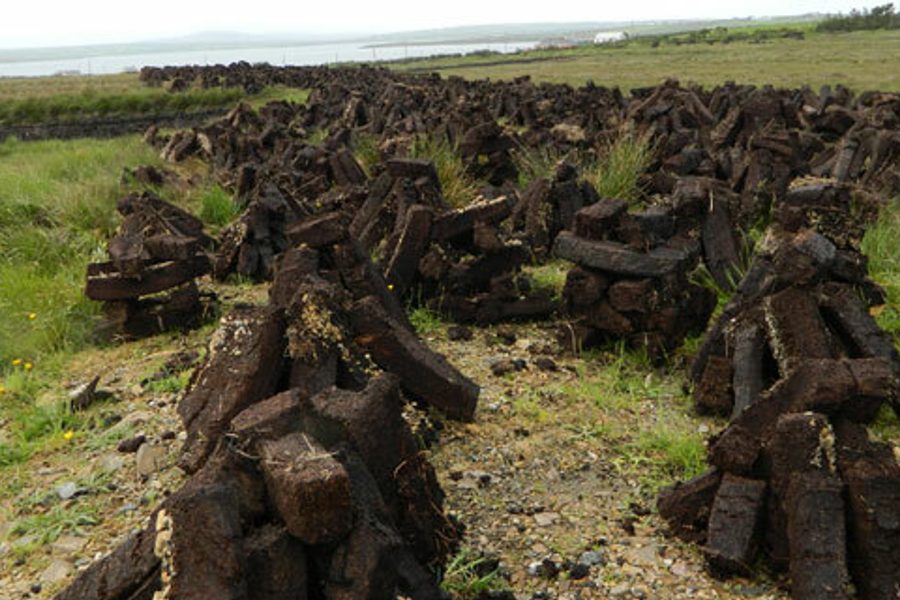
COUNTY MAYO, IRELAND — On the fog-enshrouded, windswept Atlantic coast of Ireland in County Mayo, the treeless bluffs where sheep ramble are dotted with odd pyramids of bricks of rich black sod arranged in neat rows. This is the “turf,” or strips of peat from ancient bogs, that for centuries rural residents have dried and burned to heat their homes.
This is turf-cutting season, and turf has taken on special political and social significance related to everything from Ireland’s battle for independence a century ago to the recent vote on the proposed EU austerity treaty.
Under pressure from the European Union, Ireland banned cutting turf in certain “raised bogs” that are protected areas for environmental and historical reasons.
Meanwhile, reducing the burning of turf, considered a fossil fuel, is also central to Ireland’s efforts to reduce carbon emissions as part of the EU’s combined commitment under the Kyoto Protocol. Ireland has committed to reducing its emissions 20 percent from 2005 levels by 2020, and peat — created by the decomposition of vegetation over hundreds of years — is highly carbon intensive.
But the 53 areas designated as protected bogs are on land where families have cut turf for centuries, and many see the limits as a violation of their rights and of Irish sovereignty, as well as an impingement on their economic well-being. A recent survey of 21 of the protected areas found that turf was being cut illegally in 17 of them.
Turf-cutting has become symbolic of the escalating resentment of the goverment among rural dwellers, and of divisions between rural and urban residents. Rural residents are also incensed about new taxes for septic tank inspections and other measures that they say threaten their traditional ways of life. Defending turf-cutting is part of the Standing Up for Rural Ireland campaign that nationalist party Sinn Fein invoked to rally opposition to the EU austerity treaty, which a majority of voters approved in the May 31 referendum. Treaty vote results aside, these stances helped Sinn Fein’s popularity climb significantly in the past year.
The Irish government has offered compensation to farmers for ceasing to cut peat on their family lands or offered them access to alternative unprotected bogs. But many have apparently found this solution unsatisfactory, doubting they will be adequately compensated and saying that they harvest turf in sustainable amounts developed over centures. Environmentalists counter that mechanized turf-cutting has changed things in recent years, and created large-scale commercial enterprises out of what used to be sustainable family activities. Turf-cutters oppose moves to demand commercial licenses for turf-selling among rural neighbors, and say turf is merely sold door to door by youths for pocket money.
According to its website, the Turf Cutters and Contractors Association fights to “defend the right of the Irish people to cut their own turf, for their own use, on their own turf banks, as our people have done for over 500 years and still our raised bogs remain some of the best protected in all of Europe.”
The association proposed a reform plan of its own, which the government did not adopt, leading the association in March to call for its members to break off contact with the government and to vote no in the May 31 referendum on the austerity treaty with the turf-cutting limits in mind as “evidence of the anti-Democratic and dictatorial nature of the EU.”
The integration of turf in the rural household and farming economies is evident when traveling through the country. Many roadside stands or gas stations sell turf as a home fuel, along with coal (much of it from Poland) and gas. In cozy pubs, many a fireplace is full of rich peat waiting to be burned. The air is often ripe with the acrid, loamy smell of burning peat. And in the bogs along the western coast, the land is furrowed and carved in surreal shapes from turf-cutting.
Over the Easter week in April, farmers cut turf in protected areas in a movement they referred to as a strike and commemorative of the Easter Uprising of 1916, when the Irish fought for independence from British rule.
Meanwhile, many government officials and urbanites say the turf-cutting limits and new taxes are only fair and necessary given current economic and environmental realities.
A recent op ed by Dublin Institute of Technology economics lecturer Sean Byrne in the Irish Times said rural farmers should be held accountable for the extra infrastructure costs they create that are picked up by all taxpayers, and said it is a deluded notion that rural living is somehow more ecologically-friendly than dense urban living. He critiqued farmers for resisting environmental protections even as, he wrote, much of their income is ensured by EU farm policies.
While government leaders say much progress has been made in reaching a compromise over the decade or so that turf-cutting has been controversial, the protests of turf-cutters during a meeting with EU officials in March shows the deeper issues involved are not going away any time soon. Protesters held signs saying “Sod Off EU” and told reporters that they don’t need “men in suits” in Brussels or Dublin telling them what to do.
Kari Lydersen is a Chicago-based journalist, author and assistant professor at Northwestern University, where she leads the investigative specialization at the Medill School of Journalism, Media, Integrated Marketing Communications. Her books include Mayor 1%: Rahm Emanuel and the Rise of Chicago’s 99%.








